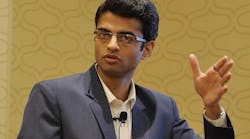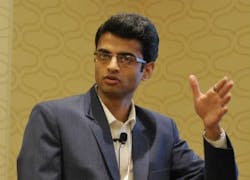“For a solar PV installation, we engineered drones to do unmanned aerial vehicle (UAV) inspections. What used to take 3,000 man-hours can now be done in three hours.” Honeywell’s Vineet Shah discussed the company’s commitment to renewable energy producers, including contracts based on outcome guarantees.
The electric power industry is going from centralized production, linear transmission and defined consumers to a decentralized matrix of producer and consumers with widely dispersed renewable sources as more consumers add solar power systems. “The grid is now distributed, and the focus is on stability, reliability and sustainability,” said Vineet Shah, director, global business strategy & partnerships, renewable energy, Honeywell Process Solutions. “Today, two-thirds of investment in capacity is in renewables.”
Shah spoke to attendees of his session, “Renewable Energy with Outcome Guarantees by Honeywell” at Honeywell Users Group Americas 2019 this week in Dallas.
“Subsidies are dying,” Shah said. “Renewables are reaching grid parity, with costs equal to or less than traditional sources. With capital investment dropping, utilities’ profitability depends more on outcomes—on operating expenses (OpEx).”
Honeywell has been involved in renewable energy (RE) for a long time, Shah said. “It used to be sporadic, but a couple of years ago, it became a focus, and now there is a group dedicated to RE.”
To reduce OpEx, the company provides system integration “with the right methodology and technology,” as well as centralized monitoring and operation, reliable data acquisition and analytics, and mobile platforms to enhance competency and safety of workers.
The company is delivering projects in solar and in storage and shifting to lifecycle management. “Upstream, we focus on optimizing levelized cost of energy (LCOE),” a measure of a power source that allows comparison of different methods of electricity generation on a consistent basis. “Downstream, we help to optimize microgrid operations and carbon footprints,” said Shah.
Many projects are based on outcomes. “What we’re actually giving customers are contractual guarantees on key performance indicators (KPIs),” which include uptime, safety and compliance reporting.
Better KPIs for every RE
For distributed and remote assets, “Honeywell connects assets, people and data with software and processes to enable outcomes,” Shah said. “For example, for an objective to reduce maintenance costs 30%, we can identify the important parameters, whether they’re people or operations, and supply hardware and software solutions to deliver the KPIs.”
Solar KPIs include performance parameters, such as availability, performance ratio and tons of carbon avoided, as well as support indicators, such as data integrity and mean time to identify (MTTI) and mean time to contain (MTTC) cyber intrusions. Technology can help to make major reductions in operational expenses. “For example, for a solar PV installation, we engineered drones to do unmanned aerial vehicle (UAV) inspections,” Shah said. “What used to take 3,000 man-hours can now be done in three hours.”
A similar approach is taken with wind power, including turbine monitoring and battery storage systems. “The more intermittent the power systems, the more you need storage,” Shah said. “We can put it together, and we can operate it.” Honeywell supplies turnkey battery energy storage system (BESS) modules and offers contractual KPIs including capacity, availability, cycle life, temperature control and round-trip efficiency.
Geothermal, biomass, hydroelectric and concentrated solar power (CSP) can benefit from similar technologies to those used for solar and wind.
Microgrids have their own control strategies, which can shift depending on the owners’ priorities: “to optimize which asset to dispatch right now, to control the load (demand reduction), to reduce carbon—whatever is your goal,” Shah said.
To reduce greenhouse gas emissions at a university in Canada, “we added solar heat pumps, geothermal, turnkey BESS, a microgrid controller and bumpless uninterruptible power supply (UPS),” he said. “The transition to and from the grid is seamless.”
For one of the largest renewable-energy companies in the United States, with more than 1,500 MW of wind assets, “we supplied all the technology for a remote operations center,” Shah said. “We successfully completed a six-site pilot and are doing site visits and documenting the next group of sites to add to it.”
Honeywell’s vision for future applications recognizes renewable energy providers’ concerns about peak prediction, battery storage and remote operations center availability. It combines multiple BESS modules, predictive analytics for maintenance, a battery management system, a remote operation center (ROC) managed by Honeywell, operation and maintenance (O&M) services and guarantees of peak prediction, ROC availability and battery performance, as a turnkey installation, Shah said.





